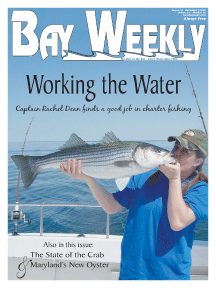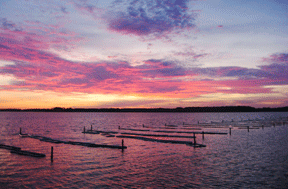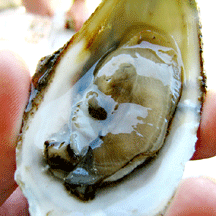
Volume XVII, Issue 35 # August 27 - September 2, 2009 |
 |
Maryland’s New Oyster
Virginica — locally born and locally raised
by Margaret Tearman
As I ate the oysters with their strong taste of the sea
and their faint metallic taste that the cold white wine
washed away, leaving only the sea taste and the suc-
culent texture, and as I drank their cold liquid from
each shell and washed it down with the crisp taste of
the wine, I lost the empty feeling and began to be
happy, and to make plans.
–Ernest Hemingway: A Moveable Feast
The Maryland and Virginia oyster, Crassostrea virginica, has a new lease on life. Asian oysters have been deported; on August 13, after five years of study costing $17 million, they were deemed “unacceptable ecological risks.”
Now the big question: Where are our oysters going to come from? Big as the Bay is, it doesn’t hold enough oysters to both cleanse the waters and satisfy our appetite.
“At one percent of historic levels, the native oyster is so low that it is likely we cannot achieve our economic and ecological goals — and the ecological comes first,” said Tom O’Connell, director of fisheries for Maryland Department of Natural Resources.
In the not-so-distant future, wild oysters will be nursed tenderly for what’s hoped to be a long life in Bay sanctuaries, filtering our waters and sheltering a host of creatures in their growing reefs.
And the Maryland oyster you eat will more than likely be farmed not wild.
In a few places, the not-so-distant-future has already arrived.
|
|
Jumpstarting the Future
On eight and a half acres in the Chincoteague Bay near Snow Hill, David Chamberlain and Luke Breza farm Great Eastern Shellfish. Along with maybe a half dozen other entrepreneurs — notably Circle C Oyster Ranching Association in St. Mary’s County and The Choptank Oyster Company in Cambridge — the Great Eastern partners are trailblazers of Maryland oyster-culture.
Inspiration came to Chamberlain in another watershed.
“I was living on a boat on the Hudson River, where we used floating docks to accommodate tides,” he said. “In the wintertime, when the floating docks were pulled out of the water, I notice blue mussels growing on them. Mussels don’t grow on the river bottom; it’s too soft. It occurred to me you could grow things on floats.”
Inspiration edged into theory. “I believe in go up and get off the bottom, where conditions are terrible. Up near the surface is a great place to raise oysters,” Chamberlain said.
By 1999, theory had spawned practice: Chamberlain had moved to Maryland and was growing oysters.
In those early years, he supplied Ocean City restaurants, making a little money on the side while still teaching industrial arts.
“The Ocean City supply was seasonal,” Chamberlain says. “I wanted to expand but couldn’t do it on my own. So I hooked up with Luke.”
Investment banker Luke Breza was back in Maryland after 15 years in Europe.
“I had seen successful oyster farms everywhere,” Breza says. “I wondered why nobody was doing it in my home state.”
Five years ago, he joined with Chamberlain to fill the void.
“I wanted to do something ecologically positive. And I love oysters. Hemmingway wrote about how oysters revitalized him, and [his words from A Moveable Feast] inspired me.”
Today Great Eastern Shellfish raises oysters for the high-end raw market, mainly in New York. True to Chamberlain’s Hudson River vision, they have a 10-year water-column aquaculture permit. Their oysters grow in bags floating a few feet under the water.
So do the oysters at Circle C Oyster Ranch.
On St. Jerome Creek, Richard Pelz (the subject of a half-dozen earlier Bay Weekly stories) farms his oysters on Floating Oyster Reefs — three-by-10-foot trademarked floats of white PVC tubing. Each reef is seeded with some 1,200 inch-long oysters, lashed to the reefs in mesh sacks suspended inches below the surface of the creek.
Water-column aquaculture as practiced at Circle C and Great Eastern Shellfish places oysters in a zone of food and oxygen where they can feast on fresh algae growing there naturally. In this environment, Pelz says he’s grown oysters from larvae to four inches in only nine months. By 18 months, they reach a jumbo six inches.
At The Choptank Oyster Company in Cambridge, one to two million oysters grow year-round in cages in the river’s tidal shallows.
“Oysters grown on the surface do not suffer the same degree as bottom dwellers,” manager Kevin McClarren told Bay Weekly. “They stay cleaner and don’t contain grit. On top they get all the algae they can eat and oxygen, so they don’t shrink in summer.”
Oysters can also be raised on bottoms, as they have been traditionally, imitating their natural beds that rise into reefs, reducing the choking effects of sediment that settles on the bottom.
Bottom leasing— renting a piece of river or Bay bottom — dates back to the 1820s in Maryland. Those leases were a little bit like homesteading. You chose a piece of bottom and recorded it at the courthouse. In 1906, a landmark law in oyster culture was passed allowing individuals to rent up to 30 acres of barren bottom in county waters and up to 100 acres in the Bay beyond county boundary limits. At one time, about 15,000 acres were leased. Maryland now records 708 bottom leases, for a total of 692.2 acres.
Back at Great Eastern Shellfish, 250 bags of oysters are now growing, with room for 750 more. “I would like to get there,” Chamberlain says, “but it would be too much work for just two guys.”
Oyster-culture is a risky business. Last year the Great Eastern Shellfish partners lost 60 percent of their oysters to disease.
“Oysters were dying left and right,” Chamberlain says. “I’ve never had this happen. The verdict is still out on what killed them. We’re hoping it’s gone, whatever it was. Our oysters are thriving now, growing like gangbusters with no deaths.”
Risky as oyster-culture is, the partners agree it is a win-win for Maryland.
“It creates jobs, cleans the environment and brings back Maryland’s oyster population,” Breza said. “And because Maryland is starting at a slow pace, we have potential to grow.”
Encouraging a New Aqua-Culture
Gov. Martin O’Malley is hoping many will follow on the oyster-culture trail today’s pioneers are blazing.
|
|
![]() Though blazing isn’t strictly accurate. Oyster-culture has been around since Roman oyster lovers cultured the mollusks in Great Britain for transport to Italy. The French oyster industry has relied on oyster-culture since the late 18th century. So does our own Pacific Northwest.
Though blazing isn’t strictly accurate. Oyster-culture has been around since Roman oyster lovers cultured the mollusks in Great Britain for transport to Italy. The French oyster industry has relied on oyster-culture since the late 18th century. So does our own Pacific Northwest.
Maryland’s fledgling oyster-culture industry generates about $1 million for the state’s economy. The potential is much greater. Virginia’s aquaculture pumps over $30 million a year into the state economy.
To encourage future oyster farmers, this year a new Shellfish Aquaculture Leasing bill rewrote laws last visited in 1906.
Hopes are high. “The new aquaculture bill helps us transition from wild harvest to oyster farming,” said Great Eastern Shellfish’s Breza.
Here’s how:
Maryland waters belong to us all, so oyster-culturists must lease their cultivation acres. But of the 708 current bottom leases, it’s anybody’s guess how many are actually in use.
“A lot of the best areas are locked up by bottom-squatters, some even passed down through families,” says Mike Naylor of Maryland Department of Natural Resources’ Fishery Service. “It costs very little [about $3.50 an acre on top of a one-time $300 application fee], so they figure they would just keep it. The new legislation includes a use-it-or-lose-it provision to increase aquaculture production.”
It will also simplify permitting, a process oyster-culturists described as horrific. Each application had to be cleared with multiple state and federal agencies, including the Army Corps of Engineers, and Maryland’s departments of both Environment and Public Works — before Maryland Department of Natural Resources could issue a permit.
Aquaculture Enterprise Zones will supposedly cut the red tape. “These are areas the state sets aside for oyster aquaculture,” Naylor said. “The state will get all the permits and will be the holder of the lease. Individuals can sublease without having to endure the permitting process.”
Calvert County hopes to get one of those zones, in the Patuxent River near Broomes Island, as soon as October 1. The state is also looking at Aquaculture Enterprise Zones on the lower Eastern Shore.
Despite the new law, “You have to have cash in hand,” Naylor said. “We don’t expect a rush. I think there will be plenty of bottom to go around. It takes two to three years to earn your first dollar, and it’s difficult to get unsecured loans to start something like this.”
Which may be why Great Eastern Shellfish’s David Chamberlain sought an investment banker as a partner.
Where to Find and Feast on Farm-Raised Maryland Oysters
|



